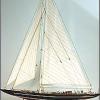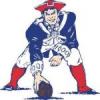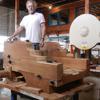-
Posts
1,811 -
Joined
-
Last visited
Reputation Activity
-
 DocBlake got a reaction from wq3296 in Fair American 1778 by jdbradford - Model Shipways - scale 1:48 - 14-gun Privateer
DocBlake got a reaction from wq3296 in Fair American 1778 by jdbradford - Model Shipways - scale 1:48 - 14-gun Privateer
Jeff: Are you sure the cannon is in proper scale? Many kits have parts that are grossly wrong scale-wise. The practicum suggests adding another bulwark plank, which you can do. But realize it will change the sheer profile and other relationships on the ship. If the gun is out of scale, replacing the cannons may be the better option. If you plan to add another plank, lay out the gun port locations (the plans should help you locate these in relationship to another part of the model; ( 6 mm aft of the aft edge of bulkhead #6 as an example). Lay out the framing and the new stanchions for the gun ports. Then add a stanchion next to each bulkhead between the ports and all the way to the bow and the stern, so the plank has support between each port also. Hope this helps
-
 DocBlake got a reaction from mrjimmy in Design and Build a Custom Work Station
DocBlake got a reaction from mrjimmy in Design and Build a Custom Work Station
Nice job! A SketchUp model would be very cool to have.
I'm building a storage cart for parts from Woodsmith plans. This is to help organize the clutter around my work area. What I'd like to do after that is build the hobby bench featured in the current edition of Woodsmith Magazine, Here are some photos of the storage cabinet and the workbench
-
 DocBlake got a reaction from Cap'n Rat Fink in Armed Virginia Sloop Patrick Henry by DocBlake - FINISHED - Lauck Street Shipyard - Scale = 1/32 - POF Admiralty Style
DocBlake got a reaction from Cap'n Rat Fink in Armed Virginia Sloop Patrick Henry by DocBlake - FINISHED - Lauck Street Shipyard - Scale = 1/32 - POF Admiralty Style
The rising wood was carefully removed from the billet and all the appropriate frames were fitted to the slots. The slots were squared up and the keel is ready to be glued up. I went a little out of sequence here by fitting the frames to the rising wood before beveling them, but I don't think it makes any difference. The strip of dark wood in the picture is rosewood, which I will use for the false keel
-
 DocBlake got a reaction from cristikc in Armed Virginia Sloop Patrick Henry by DocBlake - FINISHED - Lauck Street Shipyard - Scale = 1/32 - POF Admiralty Style
DocBlake got a reaction from cristikc in Armed Virginia Sloop Patrick Henry by DocBlake - FINISHED - Lauck Street Shipyard - Scale = 1/32 - POF Admiralty Style
The rising wood was carefully removed from the billet and all the appropriate frames were fitted to the slots. The slots were squared up and the keel is ready to be glued up. I went a little out of sequence here by fitting the frames to the rising wood before beveling them, but I don't think it makes any difference. The strip of dark wood in the picture is rosewood, which I will use for the false keel
-
 DocBlake got a reaction from jdbradford in Armed Virginia Sloop Patrick Henry by DocBlake - FINISHED - Lauck Street Shipyard - Scale = 1/32 - POF Admiralty Style
DocBlake got a reaction from jdbradford in Armed Virginia Sloop Patrick Henry by DocBlake - FINISHED - Lauck Street Shipyard - Scale = 1/32 - POF Admiralty Style
The rising wood was carefully removed from the billet and all the appropriate frames were fitted to the slots. The slots were squared up and the keel is ready to be glued up. I went a little out of sequence here by fitting the frames to the rising wood before beveling them, but I don't think it makes any difference. The strip of dark wood in the picture is rosewood, which I will use for the false keel
-
 DocBlake got a reaction from SkerryAmp in Armed Virginia Sloop Patrick Henry by DocBlake - FINISHED - Lauck Street Shipyard - Scale = 1/32 - POF Admiralty Style
DocBlake got a reaction from SkerryAmp in Armed Virginia Sloop Patrick Henry by DocBlake - FINISHED - Lauck Street Shipyard - Scale = 1/32 - POF Admiralty Style
The rising wood was carefully removed from the billet and all the appropriate frames were fitted to the slots. The slots were squared up and the keel is ready to be glued up. I went a little out of sequence here by fitting the frames to the rising wood before beveling them, but I don't think it makes any difference. The strip of dark wood in the picture is rosewood, which I will use for the false keel
-

-
 DocBlake reacted to robnbill in Brig Eagle by robnbill - 1:48
DocBlake reacted to robnbill in Brig Eagle by robnbill - 1:48
It has been a few weeks since I updated the log. The ship continues to take shape. I have completed the deck beams and added the waterways. I used a modified installation slightly different from Gene's practicum. I decided to notch the bottoms of the beams, but notch the waterway for the tops. I bent the wood for most of the waterway, but shaped the bow by cutting the shape out on the bandsaw. Once the waterway was fitted and notched, I shaped the sides to match the ships sides.
I also tested cutting the cannonball cuts using small ball shaped diamond bits in the rotary tool. These seemed to work well. I will plan on adding the pins to the waterway once the cups are all cut. I still have some details on the berth deck that I need to clean up including the sail bin was a bit tall so it has been cut down. I need to redo the sails in the tops of the bin and finish up the cabins. I have been waiting to complete these until I decided how much decking to install. While I would like to leave half the ship open, I also would like to have cannon on each side. Decisions decisions...
-
 DocBlake got a reaction from GLakie in Bomb Vessel Granado 1742 by gjdale - FINISHED - 1/48 - Cross-Section
DocBlake got a reaction from GLakie in Bomb Vessel Granado 1742 by gjdale - FINISHED - 1/48 - Cross-Section
Beautiful craftsmanship. The Bomb Vessel is spectacular.
-
 DocBlake got a reaction from gjdale in Bomb Vessel Granado 1742 by gjdale - FINISHED - 1/48 - Cross-Section
DocBlake got a reaction from gjdale in Bomb Vessel Granado 1742 by gjdale - FINISHED - 1/48 - Cross-Section
Beautiful craftsmanship. The Bomb Vessel is spectacular.
-
 DocBlake reacted to gjdale in Bomb Vessel Granado 1742 by gjdale - FINISHED - 1/48 - Cross-Section
DocBlake reacted to gjdale in Bomb Vessel Granado 1742 by gjdale - FINISHED - 1/48 - Cross-Section
I've been away all week with work, but in my absence the Admiral very kindly cleaned up the hard disk so that I could upload my photos. So here is a slightly overdue update.
Upper Deck Planking and Bulwark Lining
The upper deck was next to be installed. Once again 3/16” x 1/16” Holly was used for the deck planks, with one edge darkened with a 2B pencil to simulate the caulking. I prefer the more subtle effect the pencil caulking gives. Treenails were fitted using the drill and fill method. The only issue here was that having done lots of testing for treenail filler earlier in the build I was a bit tired and was therefore too lazy to check back through the log to ensure I was using the right one, trusting to memory instead – big mistake! I subsequently used the wrong compound, and then had to re-drill before checking and then using the correct compound. I gave the deck a coat of Wipe-on-Poly to protect it from the inevitable “pink dust” that was about to be created with the Bulwark liner installation.
Redheart was used for the Spirkiting and the Bulwark liner. The two strakes of spirkiting are 1/16” thick and the lower strake needs to be shaped to fit against the angled waterway. This was achieved in the same way as the waterway angle, by using a small hand plane. The upper strake was also angled to provide a smooth transition to the 1/32” thick bulwark lining. This upper strake also had to be cut to fit around the lower edges of gunports and sweep ports.
After some consideration and discussion with my build buddy (Mobbsie), I decided to install “iron bolts/nails” in the Spirkiting/Lining using the same method of copper nails, blackened with Liver of Sulphur, as shown previously.
Here is a picture showing the completed deck and the spirkiting/lining drilled and ready to accept the iron bolts.
Once the bolts were installed and blackened, the sprikiting/lining was given two coats of Wipe-on-Poly. The following photos were taken after the first coat had been applied. The lighting conditions don’t really do it justice – it does look a little more red to the naked eye.
-
 DocBlake got a reaction from Cap'n Rat Fink in Armed Virginia Sloop Patrick Henry by DocBlake - FINISHED - Lauck Street Shipyard - Scale = 1/32 - POF Admiralty Style
DocBlake got a reaction from Cap'n Rat Fink in Armed Virginia Sloop Patrick Henry by DocBlake - FINISHED - Lauck Street Shipyard - Scale = 1/32 - POF Admiralty Style
I am playing around with the deadwood assembly for the keel. The deadwood is made up of 4 parts glued together. I plan to blacken the joints between all the parts to simulate caulking, but I also think that some of the component parts of the deadwood can be broken down further than in the kit. For instance, parts SD1 and SD2 were probably each made up of smaller parts on a real ship. I'll simulate this by scoring lines in the parts and darkening the scoring with a pencil to simulate caulking between the parts. Here's a shot from the practicum showing the deadwood, and my proposal to alter it's appearance . What do you think?
-
 DocBlake got a reaction from Cap'n Rat Fink in Armed Virginia Sloop Patrick Henry by DocBlake - FINISHED - Lauck Street Shipyard - Scale = 1/32 - POF Admiralty Style
DocBlake got a reaction from Cap'n Rat Fink in Armed Virginia Sloop Patrick Henry by DocBlake - FINISHED - Lauck Street Shipyard - Scale = 1/32 - POF Admiralty Style
I've started gluing up the frames. Frame 0 is amidships. The frame's number increases going forward from there. Frame A is just aft of Frame 0, and the frames proceed alphabetically moving aft from there. Frames 0, 1 2 and 3 are straightforward and require no beveling. The numbered frames forward of these (#4-11) require progressively more beveling as the bow is approached. The same is true for the lettered frames moving aft. The first couple after Frame 0, Frame A and Frame B, require little or no beveling. The remainder (C through Q) are beveled. I finished and glued up the first 4 frames, 0 through 3. I'll also begin gluing up the other frames, as well as constructing the building jig and keel. My frames are maple. The deadwood, rising wood, keel, stem and stern post are all cherry. I'll add a rosewood or ebony false keel. I will also blacken the joints of all the deadwood parts to simulate caulking. I think the contrast in woods will be nice!
-
 DocBlake got a reaction from avsjerome2003 in Armed Virginia Sloop Patrick Henry by DocBlake - FINISHED - Lauck Street Shipyard - Scale = 1/32 - POF Admiralty Style
DocBlake got a reaction from avsjerome2003 in Armed Virginia Sloop Patrick Henry by DocBlake - FINISHED - Lauck Street Shipyard - Scale = 1/32 - POF Admiralty Style
I am playing around with the deadwood assembly for the keel. The deadwood is made up of 4 parts glued together. I plan to blacken the joints between all the parts to simulate caulking, but I also think that some of the component parts of the deadwood can be broken down further than in the kit. For instance, parts SD1 and SD2 were probably each made up of smaller parts on a real ship. I'll simulate this by scoring lines in the parts and darkening the scoring with a pencil to simulate caulking between the parts. Here's a shot from the practicum showing the deadwood, and my proposal to alter it's appearance . What do you think?
-
 DocBlake got a reaction from yvesvidal in Armed Virginia Sloop Patrick Henry by DocBlake - FINISHED - Lauck Street Shipyard - Scale = 1/32 - POF Admiralty Style
DocBlake got a reaction from yvesvidal in Armed Virginia Sloop Patrick Henry by DocBlake - FINISHED - Lauck Street Shipyard - Scale = 1/32 - POF Admiralty Style
I am playing around with the deadwood assembly for the keel. The deadwood is made up of 4 parts glued together. I plan to blacken the joints between all the parts to simulate caulking, but I also think that some of the component parts of the deadwood can be broken down further than in the kit. For instance, parts SD1 and SD2 were probably each made up of smaller parts on a real ship. I'll simulate this by scoring lines in the parts and darkening the scoring with a pencil to simulate caulking between the parts. Here's a shot from the practicum showing the deadwood, and my proposal to alter it's appearance . What do you think?
-
 DocBlake got a reaction from aviaamator in Armed Virginia Sloop Patrick Henry by DocBlake - FINISHED - Lauck Street Shipyard - Scale = 1/32 - POF Admiralty Style
DocBlake got a reaction from aviaamator in Armed Virginia Sloop Patrick Henry by DocBlake - FINISHED - Lauck Street Shipyard - Scale = 1/32 - POF Admiralty Style
I've started gluing up the frames. Frame 0 is amidships. The frame's number increases going forward from there. Frame A is just aft of Frame 0, and the frames proceed alphabetically moving aft from there. Frames 0, 1 2 and 3 are straightforward and require no beveling. The numbered frames forward of these (#4-11) require progressively more beveling as the bow is approached. The same is true for the lettered frames moving aft. The first couple after Frame 0, Frame A and Frame B, require little or no beveling. The remainder (C through Q) are beveled. I finished and glued up the first 4 frames, 0 through 3. I'll also begin gluing up the other frames, as well as constructing the building jig and keel. My frames are maple. The deadwood, rising wood, keel, stem and stern post are all cherry. I'll add a rosewood or ebony false keel. I will also blacken the joints of all the deadwood parts to simulate caulking. I think the contrast in woods will be nice!
-
 DocBlake got a reaction from SkerryAmp in Armed Virginia Sloop Patrick Henry by DocBlake - FINISHED - Lauck Street Shipyard - Scale = 1/32 - POF Admiralty Style
DocBlake got a reaction from SkerryAmp in Armed Virginia Sloop Patrick Henry by DocBlake - FINISHED - Lauck Street Shipyard - Scale = 1/32 - POF Admiralty Style
I am playing around with the deadwood assembly for the keel. The deadwood is made up of 4 parts glued together. I plan to blacken the joints between all the parts to simulate caulking, but I also think that some of the component parts of the deadwood can be broken down further than in the kit. For instance, parts SD1 and SD2 were probably each made up of smaller parts on a real ship. I'll simulate this by scoring lines in the parts and darkening the scoring with a pencil to simulate caulking between the parts. Here's a shot from the practicum showing the deadwood, and my proposal to alter it's appearance . What do you think?
-
 DocBlake got a reaction from BareHook in Armed Virginia Sloop Patrick Henry by DocBlake - FINISHED - Lauck Street Shipyard - Scale = 1/32 - POF Admiralty Style
DocBlake got a reaction from BareHook in Armed Virginia Sloop Patrick Henry by DocBlake - FINISHED - Lauck Street Shipyard - Scale = 1/32 - POF Admiralty Style
I am playing around with the deadwood assembly for the keel. The deadwood is made up of 4 parts glued together. I plan to blacken the joints between all the parts to simulate caulking, but I also think that some of the component parts of the deadwood can be broken down further than in the kit. For instance, parts SD1 and SD2 were probably each made up of smaller parts on a real ship. I'll simulate this by scoring lines in the parts and darkening the scoring with a pencil to simulate caulking between the parts. Here's a shot from the practicum showing the deadwood, and my proposal to alter it's appearance . What do you think?
-
 DocBlake got a reaction from dgbot in Armed Virginia Sloop Patrick Henry by DocBlake - FINISHED - Lauck Street Shipyard - Scale = 1/32 - POF Admiralty Style
DocBlake got a reaction from dgbot in Armed Virginia Sloop Patrick Henry by DocBlake - FINISHED - Lauck Street Shipyard - Scale = 1/32 - POF Admiralty Style
I am playing around with the deadwood assembly for the keel. The deadwood is made up of 4 parts glued together. I plan to blacken the joints between all the parts to simulate caulking, but I also think that some of the component parts of the deadwood can be broken down further than in the kit. For instance, parts SD1 and SD2 were probably each made up of smaller parts on a real ship. I'll simulate this by scoring lines in the parts and darkening the scoring with a pencil to simulate caulking between the parts. Here's a shot from the practicum showing the deadwood, and my proposal to alter it's appearance . What do you think?
-
 DocBlake got a reaction from yvesvidal in Armed Virginia Sloop Patrick Henry by DocBlake - FINISHED - Lauck Street Shipyard - Scale = 1/32 - POF Admiralty Style
DocBlake got a reaction from yvesvidal in Armed Virginia Sloop Patrick Henry by DocBlake - FINISHED - Lauck Street Shipyard - Scale = 1/32 - POF Admiralty Style
I've started gluing up the frames. Frame 0 is amidships. The frame's number increases going forward from there. Frame A is just aft of Frame 0, and the frames proceed alphabetically moving aft from there. Frames 0, 1 2 and 3 are straightforward and require no beveling. The numbered frames forward of these (#4-11) require progressively more beveling as the bow is approached. The same is true for the lettered frames moving aft. The first couple after Frame 0, Frame A and Frame B, require little or no beveling. The remainder (C through Q) are beveled. I finished and glued up the first 4 frames, 0 through 3. I'll also begin gluing up the other frames, as well as constructing the building jig and keel. My frames are maple. The deadwood, rising wood, keel, stem and stern post are all cherry. I'll add a rosewood or ebony false keel. I will also blacken the joints of all the deadwood parts to simulate caulking. I think the contrast in woods will be nice!
-
 DocBlake got a reaction from jdbradford in Fair American 1778 by jdbradford - Model Shipways - scale 1:48 - 14-gun Privateer
DocBlake got a reaction from jdbradford in Fair American 1778 by jdbradford - Model Shipways - scale 1:48 - 14-gun Privateer
Great progress, Jeff. Good job on the planking and finishing,
-
 DocBlake got a reaction from jdbradford in Fair American 1778 by jdbradford - Model Shipways - scale 1:48 - 14-gun Privateer
DocBlake got a reaction from jdbradford in Fair American 1778 by jdbradford - Model Shipways - scale 1:48 - 14-gun Privateer
Try the stealer(s) near the keel, right next to the garboard strake.
-
 DocBlake got a reaction from jdbradford in Armed Virginia Sloop Patrick Henry by DocBlake - FINISHED - Lauck Street Shipyard - Scale = 1/32 - POF Admiralty Style
DocBlake got a reaction from jdbradford in Armed Virginia Sloop Patrick Henry by DocBlake - FINISHED - Lauck Street Shipyard - Scale = 1/32 - POF Admiralty Style
I've started gluing up the frames. Frame 0 is amidships. The frame's number increases going forward from there. Frame A is just aft of Frame 0, and the frames proceed alphabetically moving aft from there. Frames 0, 1 2 and 3 are straightforward and require no beveling. The numbered frames forward of these (#4-11) require progressively more beveling as the bow is approached. The same is true for the lettered frames moving aft. The first couple after Frame 0, Frame A and Frame B, require little or no beveling. The remainder (C through Q) are beveled. I finished and glued up the first 4 frames, 0 through 3. I'll also begin gluing up the other frames, as well as constructing the building jig and keel. My frames are maple. The deadwood, rising wood, keel, stem and stern post are all cherry. I'll add a rosewood or ebony false keel. I will also blacken the joints of all the deadwood parts to simulate caulking. I think the contrast in woods will be nice!
-
 DocBlake got a reaction from mrshanks in Armed Virginia Sloop Patrick Henry by DocBlake - FINISHED - Lauck Street Shipyard - Scale = 1/32 - POF Admiralty Style
DocBlake got a reaction from mrshanks in Armed Virginia Sloop Patrick Henry by DocBlake - FINISHED - Lauck Street Shipyard - Scale = 1/32 - POF Admiralty Style
I agree, Jeff. I built the MS AVS using Bob's practicum and these are two different kits, altogether. The POF "Patrick Henry" is going to be worth every penny.
-
 DocBlake got a reaction from Cap'n Rat Fink in Armed Virginia Sloop Patrick Henry by DocBlake - FINISHED - Lauck Street Shipyard - Scale = 1/32 - POF Admiralty Style
DocBlake got a reaction from Cap'n Rat Fink in Armed Virginia Sloop Patrick Henry by DocBlake - FINISHED - Lauck Street Shipyard - Scale = 1/32 - POF Admiralty Style
Thanks, Dan.
The first step in the build is to make the frames. They come attached to the hardwood billets by two tabs. I found the easiest was to remove them from the billet was to use a Dremel tool and a cutoff wheel. In the photo, if you look carefully, you can see the burned area on the billet where the parts had been attached. Each frame is made up of 9 or 10 parts. The tabs are then cut off of each part, and the parts lightly sanded. The first layer of parts is stuck to a template of the frame with double sided tape, and the second overlapping "sistered" layer of parts is glued to the first. The photo gives an idea of scale















